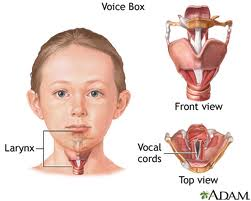
Larynx is that part of our respiratory system which helps in producing voice, helps in swallowing as well as breathing. Each time the body inhales or exhales, the air passes in and out of larynx. From the lungs, air passes over the stretched vocal chords, and the vibrations are eventually modified by the palate, tongue and lips so as to produce speech.

Larynx is made up of muscles alongwith tough and flexible tissues known as cartilages. There are numerous muscles in Larynx with three large unpaired and three paired cartilages thus making it up to nine cartilages. The three unpaired large cartilages are thyroid, cricoid and epiglottis while the other three paired cartilages are arytenoids, corniculate and cuneiform. The thyroid cartilage is on the anterior side and also forms the Adam’s apple, the projection at the middle of our neck, which is more prominent and larger in male than female. The lower and posterior part of Larynx is made up of a thicker and stronger cricoids cartilage which is smaller than the thyroid cartilage. The epiglottis is a leaf-shaped cartilage which is projected upwards and lies behind the tongue. Then, there are the two arytenoids cartilages which are above the cricoid cartilage and towards the back of Larynx. Both are pyramid-shaped. The corniculate cartilages are conical and yellow, and they connect to the arytenoids cartilages prolonging towards the back of the Larynx. The last pair, cuneiform cartilages, sits on a mucous membrane right in front of the arytenoid cartilages.
The Larynx has epiglottis on the top, which is joined below by the thyroid cartilage forming the Adam’s apple. Below this is the pair of arytenoid cartilages with cuneiform cartilages in the front and corniculate cartilages at the back. Between the arytenoids cartilages and towards the inner side of the Adam’s apple lie two fibrous sheets of tissues known as vocal cords. At the bottom of the Larynx is the cricoids cartilage.
Larynx, since it is also known as voice box, is mainly responsible for producing voices through its vocal cords. Thus, its main function is phonation- production of sound. It also prevents choking with the help of the epiglottis that closes the entrance of Larynx, like a lid whenever we swallow food, preventing the food from entering the windpipe. Otherwise, the epiglottis remains open and the vocal cords are closed letting the air to pass in and out through Larynx.
The voice is produced through the vibration of the vocal cords (also known as vocal folds). This pair of vocal cords, like a pair of flaps, remain open while breathing but are closed while speaking or swallowing food. When we speak, the air from the lungs comes out towards the vocal cords and the air forcefully creates a vibratory motion of it. Then, a repetitive vibratory cycle is created which is then modified by the tongue, lips and palate for a proper speech.
Some of the Laryngeal diseases are as follows:
Laryngitis: It is the condition when there is an inflammation of the Larynx leading to hoarse voice. It is mainly caused by cold or flu. It can also be a result of over cheering during a sport or irritation caused due to allergies or smoke.
Laryngeal cancer: It is the growth of cancer in the Larynx and it is also known as laryngeal carcinoma.
Polyp of Larynx: This disease has an abnormal growth of tissue from the mucous membrane of the walls of Larynx.
G Kowledge of | 0 Comments >>
0 Comments
Leave Comment
Your email address will not be published. Required fields are marked.